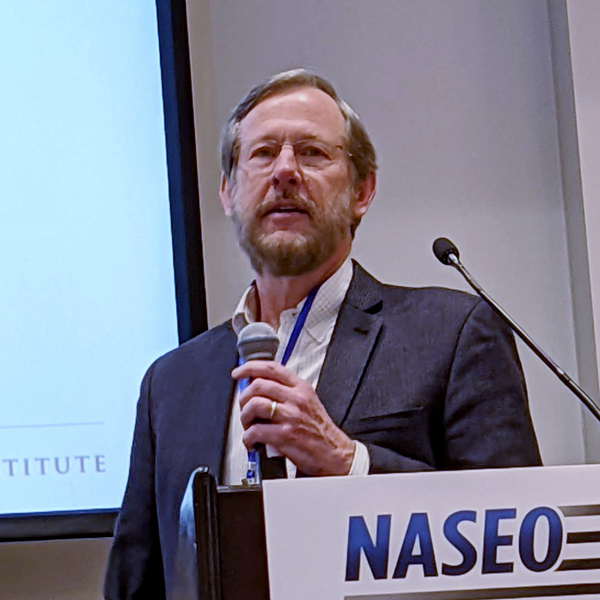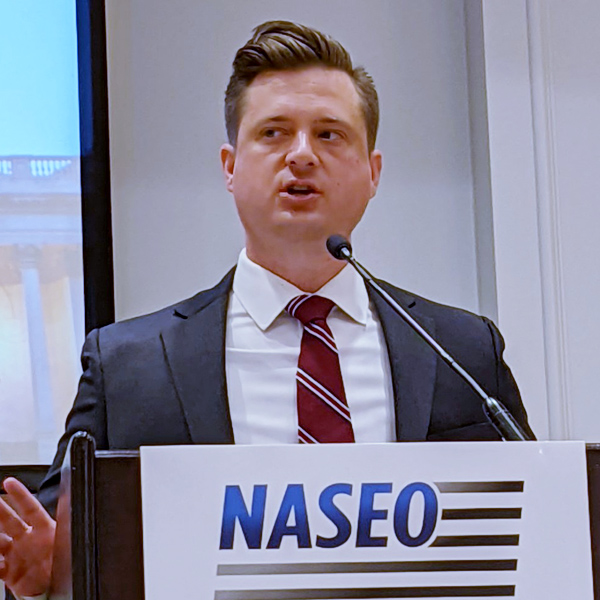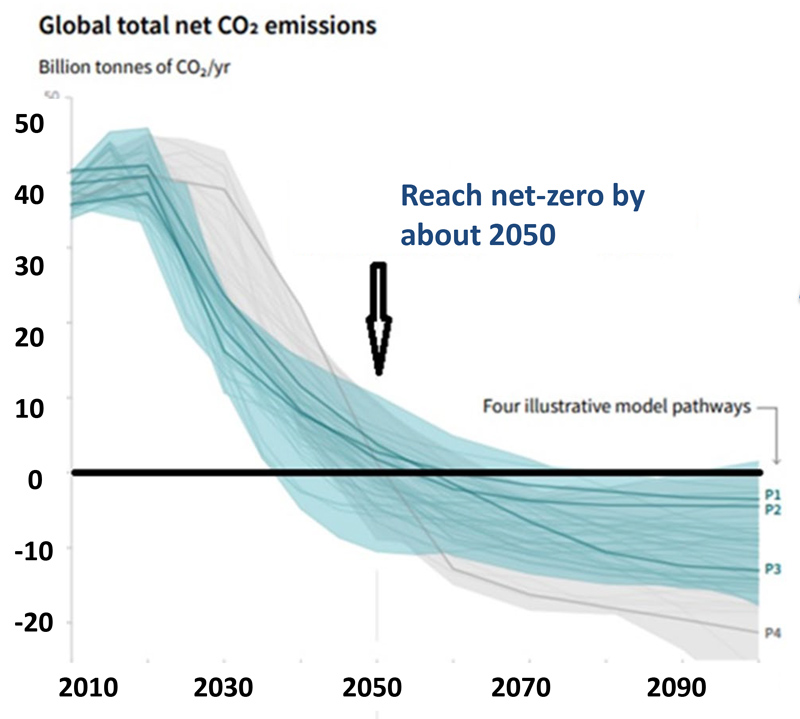The term “clean energy” has become a flashpoint in current debates swirling around decarbonizing the U.S. electric system.
Should it be defined solely in terms of renewable technologies — wind, solar, storage hydropower and, maybe, nuclear?
Or, with climate change intensifying extreme weather events across the U.S. and worldwide, is a broader view — encompassing hydrogen, natural gas and carbon capture — required to drive rapid and deep reductions in greenhouse gas emissions?
Speakers at the recent Energy Policy Outlook Conference of the National Association of State Energy Officials (NASEO) leaned strongly toward the latter approach, reflecting the broad range of political, economic and technical issues surrounding state-level plans for cutting emissions to net-zero by midcentury.
 Karl Hausker, WRI | © RTO Insider LLC
Karl Hausker, WRI | © RTO Insider LLC“Nearly all states that have set a goal of zero-carbon for their utilities define it in terms of 100% clean energy, not 100% renewables,” Karl Hausker, senior fellow for climate policy at the World Resources Institute, told conference attendees at a Feb. 9 panel on decarbonization pathways.
The reason, he said, is that “as a power system approaches 100% renewable, system costs increase sharply … and maintaining reliability becomes more difficult.”
Hausker argued for a five-point strategy for getting the U.S. economy to net zero, including deep efficiency, broad electrification and increasing electricity supply, while also commercializing carbon capture and sequestration (CCS) technologies and aggressively pursuing a range of research and development efforts.
“We are betting on solutions, and there is a big case for spreading our chips, like we do in Las Vegas,” he said. “The good news is that if we can do this smartly and efficiently and wisely, we can keep the cost of this transition to 1 or 2% of global GDP or 2% of U.S. GDP. That’s a pretty good price to pay for the damages [of climate change] that are already being felt in the world.”
 Richard Meyer, AGA | © RTO Insider LLC
Richard Meyer, AGA | © RTO Insider LLCSpeaking on the same panel, Richard Meyer, vice president for energy markets at the American Gas Association (AGA), also called for a multipronged approach to net zero, but with a central role for natural gas to ensure reliability, affordability and minimum disruption for Americans who rely on gas for space and water heat.
Drawing on figures from the EPA and the Energy Information Administration, Meyer said that natural gas accounts for 13% of U.S. greenhouse gas emissions, most of which are produced by residential, commercial and industrial customers. A new report from the AGA outlines four key strategies for cutting those emissions: reducing the industry’s methane emissions, improving efficiency, decarbonizing the gas supply via renewable natural gas and hydrogen, and offsetting emissions with carbon capture and sequestration and direct air capture.
“There is no one single pathway to zero,” Meyer said. “Gas utilities, gas infrastructure can play crucial and enduring roles … Decarbonization planning, including the evaluation of gas and carbon mitigation strategies, have to be examined with regional-level assessments and evaluated by their ability to support tenets aligned with safety, reliability, affordability, resilience and feasibility.”
Net-negative emissions
The reality of climate change, and the realization that avoiding its worst impacts will require economy-wide, transformative decarbonization, is no longer a point of contention in the energy sector. Nor is the prominent role renewable technologies and electrification must play in the transition.
Rather, the debate now centers on what role, if any, fossil fuels — the main source of the greenhouse gas emissions driving climate change — can or should play, while also considering how deeply integrated they are in global power systems and economies.
Speaking on a later panel at the NASEO conference, Jennifer Wilcox, principal deputy assistant secretary for the Office of Fossil Fuels and Carbon Management at the Department of Energy, framed carbon capture technologies as a solution for hard-to-decarbonize industries, such as steel and cement.
 The need for net-negative emissions | IPCC
The need for net-negative emissions | IPCC“A big focus of what we’re looking at is not just the sectors that we’re dependent upon today that are sourced from fossil fuels, but those that are expected to be committed through midcentury,” Wilcox said. “And so, when we look at the power sector, it’s not that CCS is a blanket solution across all fossil fuel-fired power plants, but we look at what is the infrastructure that’s expected to persist through midcentury, and those are really good targets potentially for CCS.”
Hausker believes that despite ongoing efforts to curb GHG emissions, the U.S. will probably not meet the emission reduction targets needed to keep climate change to the 1.5-degree or even 2-degree target set in the UN Paris agreement and confirmed at the recent Climate Change Conference in Glasgow.
“So, beginning midcentury and continuing on for the rest of the century, we will have to get into a net-negative emissions posture,” he said. “We will have to take more CO2 out of the air than we may still be putting in midcentury and beyond.”
CCS and direct air capture could be critical in such a scenario, he said. Further, Hausker argued that while the costs of renewable wind and solar have dropped, the industry standard for comparing the cost of different fuels — the levelized cost of energy (LCOE) — “is a flawed metric.”
“It’s really important for policy makers and policy influencers to focus on system costs, not the LCOE,” which is based on the average cost of a megawatt-hour of power from a standalone plant, he said. The system cost is “the cost that consumers ultimately pay … including all the technologies needed to maintain a reliable grid.”
Thus, even if wind and solar are themselves cheaper than fossil fuels, system costs for a 100% renewable grid might be high.
Further, while existing storage technologies have solved the problem of the minute-to-minute variability of renewables, further research will be needed to ensure reliability across daily and seasonal weather patterns, he said. When wind or solar generation drops for days at time, “you better have something to turn on,” he said.
A Moral Hazard Question
The natural gas industry has long maintained that its resources are needed to back up the intermittency of renewables.
“Part of the value of what the gas system does for us today is its ability to store and transport large amounts of energy to meet seasonal and daily energy use,” Meyer said. “An integrated approach to decarbonization that leverages the advantages of the gas distribution system is likely to support a more effective, reliable and resilient transition to a net-zero energy system and minimizes negative impacts for customers.”
In the U.S., planning for decarbonization will also need to take “highly localized” regional differences into account. Such factors might include “climate and temperatures … energy prices,” he said. “What does the housing stock look like? What kind of businesses are using gas?”
The AGA report lays out four pathways to net zero by 2050, based on different combinations of efficiency, hybrid gas-electric heating, a mix of other technologies, and renewable natural gas and carbon capture technologies. A key finding, all four of the pathways would increase the number of customers served by natural gas utilities, Meyer said. “In other words, we don’t have to make a choice between adding new customers and helping them achieve ambitious environmental goals.”
Moderating the decarbonization panel, Joe Pater, director of the Office of Energy Innovation at Wisconsin’s Public Service Commission, provided a real-life example of the challenges his state faces as it increases renewable energy and storage, and explores electrifying home heating.
The state has heavily promoted “high-efficiency natural gas furnaces over the last few decades,” he said. “But now we are talking about heat pumps, and we’re talking about cold-climate heat pumps that are coming to market. From the contractor perspective, we’re kind of getting a little bit of pushback, so I think the reality here is that renewable natural gas is going to need to be a bigger factor in Wisconsin.”
Solving such problems will require a short list of regulatory actions, Meyer said, including expanding equity, energy efficiency and demand-side management programs and updating rate structures and cost recovery “so all parties are incented and support greenhouse gas emissions reductions.”
“Methods to compensate our customers for the services they provide to other parts of the energy system” should also be considered, he said.
In his closing remarks, Hausker acknowledged the environmental arguments against carbon capture — that it is too expensive, does not work and prolongs our dependence on fossil fuels. While he disagrees with the first two points, he said, the idea of prolonged dependence raises a “moral hazard question.”
“Just perfecting the technology, commercializing it, do we create a moral hazard where we’re just likely to keep burning fossil fuels? You can’t dismiss that,” he said. “We have to balance that moral hazard problem against the very physical hazard of what if we come to 2040 or 2050 and we have no means to take out of the climate the CO2 that we need to at that point?”


